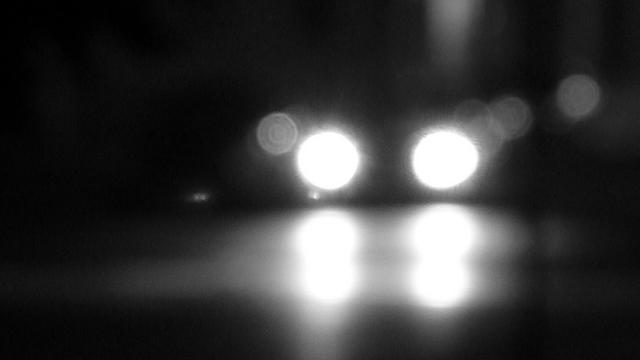Less a function of fear than bewilderment; simply put, deer freeze in headlights because they can’t see.
Deer Eyes vs. Human Eyes
The eyes of deer and people share a number of features, but they also have a few significant differences.
Pupil
Unlike human pupils, which are round and when dilated do not span much of the eye, deer pupils are elliptical (like a cat’s) and can dilate to cover the entire width of the orb. This greater dilation allows a lot more light to reach the retina, improving vision particularly at dawn and dusk when deer are most active.
Lens
The lens of a deer’s eye is larger than a human’s, and this allows more light to penetrate to the retina.
In addition, because people are most active during the day, our lenses are slightly yellow to filter out damaging ultraviolet rays. By contrast, since deer are active at night and have little danger of eye damage from ultraviolet light, their lenses are clear, which enable deer to see a bit of the UV spectrum — ultimately giving it even better night vision.
Tapetum
Essentially a reflector at the back of the eye (behind the retina), the tapetum lucidum reflects light back again across the retina, drastically increasing its light exposure.
Although not found in humans, it is a common bit of eye anatomy in the animal world. This reflective layer is found in dogs, cats, raccoons, rodents, birds and even fish, and is the cause of eyeshine — or the reflective glowing often seen when a light hits an animal in the dark.
Retina
Both deer and humans have two types of photoreceptors on the retina — rods and cones.
The cones are activated by brighter light and are sensitive to colour, as well as help with distance vision. People have three different types of cone cells, each sensitive to a different colour light — red, blue and green. On the other hand, deer have only two types of cone cells, those that can see blue and yellow.
As a result, deer see red and orange poorly, and also do not see detail and at a distance as clearly as humans.
However, deer have a much greater proportion of rod cells. Rods enable both humans and deer to distinguish between light and dark and to see in dim light (and at night). Since deer have many more rods, they are better able to see in low light, and thus have far superior night vision.
Rhodopsin
Within the rods is a pigment, called rhodopsin, that absorbs light, and in particular favours green-blue and red-purple light (from which its nickname, visual purple, derives). Because of rhodopsin’s ability to bring more light into the rods, and its affinity for those colours that are most present at night, it aids with night vision. And, because deer have more rods, and therefore more rhodopsin, their ability to absorb light at night, and see, is that much greater.
However, after rhodopsin absorbs light, the pigment breaks down into its component parts — scotopsin and retinal. During exposure to continuous light, like daylight, rhodopsin becomes completely decomposed, and the eye becomes less sensitive to light due to its absence. Although the pigment will regenerate, that can take some time, and the absence of light.
Non-continuous flashes will also break down rhodopsin, but not before the flash overloads the system.
Flash Blindness
When an eye that has been in the dark long enough to regenerate significant quantities of rhodopsin is suddenly exposed to bright light, a phenomenon of “bleaching,” or oversaturation, occurs, and on a massive scale. The result in humans is temporary, or flash, blindness.
With deer, remember that their pupils are larger and far more dilated at night than a human eye. Compound this with the greater amount of light that will reach the retina due to their larger lens, as well as their higher concentration of rods (and rhodopsin), and multiply that by two thanks to their tapetum, together this creates a perfect storm of oversaturation.
Add to this the fact that, up to the point of blinding light, the deer had been enjoying terrific night sight (thanks also to their UV vision), and the combined effect of sudden blindness must be bewildering and overwhelming — causing the deer to potentially freeze.
Bonus Deer Facts:
- It has been reported that nearly 1 million deer-related motor vehicle accidents happen each year in the U.S. In 2011, these caused approximately 200 human deaths and 10,000 personal injuries, as well as $US1 billion in financial damage.
- Depending on the state and weapon used (bow, crossbow, rifle, etc.), deer season can start as early as August and end as late as February, although October and November are perhaps the most popular months. Millions of deer are killed during the season, and in 2008 alone, the U.S.’s 10 million hunters killed 6.2 million deer.
- Hunting proponents note that, absent predation, two deer “can produce a herd of up to 135 deer in 7 years,” which may over-browse an ecosystem, ultimately resulting in insufficient food for the herd and death from starvation. On the other hand, animal rights activists assert that, rather than culling the herd of the sick and weak, as natural predators would, hunters often take the handsomest and healthiest of the group, resulting in a weakened herd.
- Ultraviolet brighteners, also called optical brighteners, are often added to laundry detergents to make the clothes look brighter. Deer hunters (and service members on deployment) are cautioned to avoid these, as they can make the hunter (or soldier) more visible to prey (or the enemy) in low light conditions.
Picture: Steve Johnson/Flickr
Melissa writes for the wildly popular interesting fact website TodayIFoundOut.com. To subscribe to Today I Found Out’s “Daily Knowledge” newsletter,click here or like them on Facebook here. You can also check ’em out on YouTube here.
This post has been republished with permission from TodayIFoundOut.com.
